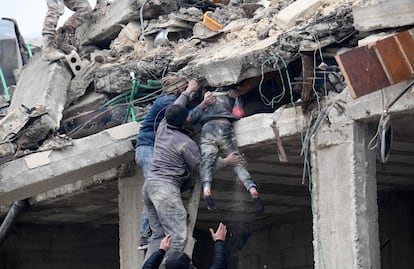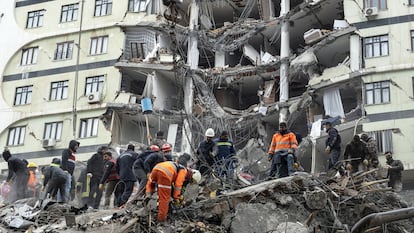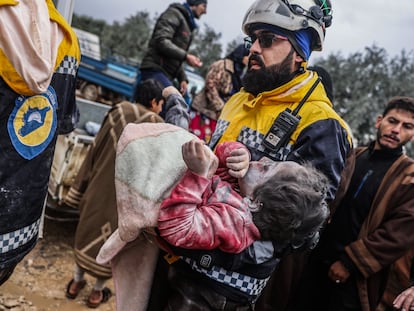Turkey’s curse: 50 earthquakes in a century
The country is located at the crossroads of tectonic plates and crossed by two great faults. Experts keep warning that building construction needs to be improved and drills carried out to train the population

People who live in Turkey have a special sensitivity to earthquakes. Every time the ground moves or a door or window shakes, however slightly, however much it may be an almost imperceptible movement, the phones begin to ring and the WhatsApp groups are filled with questions: “Did you feel that? Is it an earthquake? Are you OK?”. It is an understandable fear, given that just about everyone in this country has experienced an earthquake of considerable magnitude at one time or another.
It might have been in the east (Van, in 2011, with more than 600 deaths) or in the west (Izmir, in 2020, with more than 100 deaths), in the south or in the north of the country. An entire generation that grew up in Istanbul and around the Sea of Marmara – the most populated area in Turkey – has deep traumas from the 1999 earthquake, in which more than 17,000 people died. Everyone remembers with photographic precision what they were doing at that time and in the days that followed; and it’s usually one of the stories they tell each other when a friendship begins to take shape, perhaps as a way to exorcise ghosts and shared fears. Because one of the recurring themes on Turkish television is precisely: when will the next big earthquake hit?
“We know where earthquakes are going to occur and we know if they will be strong or not. But we do not have clear information to predict when they are going to happen,” explains Eulàlia Masana, professor of Internal Geodynamics at the University of Barcelona. And Turkey is one of those places where earthquakes are known to occur, because seismic movements are concentrated at the limits of the Earth’s tectonic plates, and several of them come together in this country.
Turkey is crossed by two great faults: the North Anatolian fault and the East Anatolian fault, along which the earthquake occurred on Monday. “It is a point where the Anatolian plate converges to the west; to the east, the Arabian plate; to the north, the Eurasian plate, and to the southwest, the African one,” explains Masana. The Arabian plate, explains the expert, moves north at a rate of about two centimeters (0.79 inches) a year, while the African plate moves in the same direction, although at a slower speed. The Anatolian one, for its part, is expelled to the west by the movement of the aforementioned faults. All these movements generate geological tensions that lead to earthquakes of greater or lesser magnitude.
In the last 100 years, there have been more than 50 earthquakes of magnitude equal to or greater than 6 on the Richter scale in Turkey, which is equivalent to a “strong” earthquake that can destroy populated areas within a radius greater than 150 kilometers (93 miles). The combined death toll was in excess of 80,000 people. The most destructive one occurred in 1939 in the province of Erzincan, with 32,000 deaths; this is the quake that Turkish President Recep Tayyip Erdoğan mentioned in recent statements, comparing it with the tragedy on Monday.
“We don’t know when the next earthquake will occur,” continues Masana, “but we do know how to proceed: in areas with great seismic activity, drills must be carried out and there must be earthquake-resistant construction.” Serif Baris, a professor of geophysical engineering at Turkey’s Kocaeli University, on Monday lamented on CNN-Türk the lack of preparation of the general population, which often leads to incorrect reactions to earthquakes: people who jump out the window when they feel an earthquake, or drive away in their vehicles, blocking the roads through which help must arrive. A few months ago, the Turkish Emergency Management Agency (AFAD) carried out a national test, sending alerts to all cellphones in the country: in many cases the messages arrived hours after the scheduled time for the drill.

“We know that there will be earthquakes, we have lived through them, we have experience with them because they occur frequently, and sometimes they are very destructive. And one of the main reasons why they are so destructive is the quality of the constructions,” says the president of the Izmir Chamber of Civil Engineers, Eylem Ulutas Ayatar. After the 1999 earthquake, which was catastrophic due to the poor quality of many buildings and the poor response capacity by the state, numerous agencies were reformed. In fact, Turkey’s civil protection teams are now among the most experienced in the region.
However, the promise made then that infrastructure and housing would be renovated and inspected has not moved at the same speed. “The infrastructure inspection system promised in 1999 was only implemented, in pilot mode, in 19 provinces and was not extended to all of Turkey until after the Van earthquake occurred, 12 years later,” explains Ayatar.
In 2011, Erdoğan – who was then the prime minister – promised to overhaul Turkey’s buildings and introduce anti-seismic measures. Most new buildings now include such measures, but experts warn that legislation is not always complied with. “Now, what the country needs most is cooperation to rescue people trapped under the rubble, as well as blankets and food for the victims, and help to overcome the trauma,” says Ayatar. “But once that happens, we must ask ourselves why, every time there is an earthquake, we have to learn the hard way that it is time to apply the laws, the technical knowledge and the experience that we already have to reduce its impact.”
Sign up for our weekly newsletter to get more English-language news coverage from EL PAÍS USA Edition
Tu suscripción se está usando en otro dispositivo
¿Quieres añadir otro usuario a tu suscripción?
Si continúas leyendo en este dispositivo, no se podrá leer en el otro.
FlechaTu suscripción se está usando en otro dispositivo y solo puedes acceder a EL PAÍS desde un dispositivo a la vez.
Si quieres compartir tu cuenta, cambia tu suscripción a la modalidad Premium, así podrás añadir otro usuario. Cada uno accederá con su propia cuenta de email, lo que os permitirá personalizar vuestra experiencia en EL PAÍS.
¿Tienes una suscripción de empresa? Accede aquí para contratar más cuentas.
En el caso de no saber quién está usando tu cuenta, te recomendamos cambiar tu contraseña aquí.
Si decides continuar compartiendo tu cuenta, este mensaje se mostrará en tu dispositivo y en el de la otra persona que está usando tu cuenta de forma indefinida, afectando a tu experiencia de lectura. Puedes consultar aquí los términos y condiciones de la suscripción digital.
More information
Archived In
Últimas noticias
Venezuela hardens its ‘revolutionary state’ project amid pressure from Trump
Sydney Sweeney, the actress praised by Trump: ‘Women are up against what society wants them to be’
The Bolsonaro surname: An advantage or liability in Brazil’s 2026 presidential elections?
Raúl Rocha, from jet-setting with Miss Universe to arms trafficking and fuel theft
Most viewed
- Reinhard Genzel, Nobel laureate in physics: ‘One-minute videos will never give you the truth’
- Pablo Escobar’s hippos: A serious environmental problem, 40 years on
- Charles Dubouloz, mountaineering star, retires at 36 with a farewell tour inspired by Walter Bonatti
- Why we lost the habit of sleeping in two segments and how that changed our sense of time
- The fall of a prolific science journal exposes the billion-dollar profits of scientific publishing










































